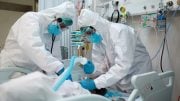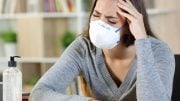
Half of the patients who were admitted to the hospital with COVID-19 still have at least one symptom two years later.
- Study of 1,192 participants hospitalized with COVID-19 in Wuhan, China, between January 7th and May 29th, 2020, followed up at six months, 12 months, and two years after discharge.
- Physical and mental health improved over time regardless of initial disease severity, with 55% reporting at least one symptom caused by the initial COVID-19 infection at two years compared to 68% at six months.
- In general, patients recovered from COVID-19 tend to be in poorer health two years after the initial infection compared to the general population, indicating some patients need more time to recover fully.
- Around half of study participants had symptoms of long COVID – such as fatigue and sleep difficulties – at two years, and experienced poorer quality of life and ability to exercise, more mental health issues, and increased use of health-care services compared to those without symptoms of long COVID.
Two years after infection with COVID-19, half of the patients who were admitted to the hospital still have at least one symptom, according to the longest follow-up study to date, published on May 11, 2 in The Lancet Respiratory Medicine. The research study followed 1,192 participants in China infected with SARS-CoV-2 during the first phase of the pandemic in 2020.
While physical and mental health generally improved over time, the analysis suggests that COVID-19 patients still tend to have poorer health and quality of life than the general population. This is especially the case for participants with long COVID, who typically still have at least one symptom including fatigue, shortness of breath, and sleep difficulties two years after initially falling ill.[1]
The long-term health impacts of COVID-19 have remained largely unknown, as the longest follow-up studies to date have spanned around one year.[2] The lack of pre-COVID-19 health status baselines and comparisons with the general population in most studies have also made it difficult to determine how well patients with COVID-19 have recovered.
Lead author Professor Bin Cao, of the China-Japan Friendship Hospital, China, says: “Our findings indicate that for a certain proportion of hospitalized COVID-19 survivors, while they may have cleared the initial infection, more than two years is needed to recover fully from COVID-19. Ongoing follow-up of COVID-19 survivors, particularly those with symptoms of long COVID, is essential to understand the longer course of the illness, as is further exploration of the benefits of rehabilitation programs for recovery. There is a clear need to provide continued support to a significant proportion of people who’ve had COVID-19, and to understand how vaccines, emerging treatments, and variants affect long-term health outcomes.”
The authors of the new study sought to analyze the long-term health outcomes of hospitalized COVID-19 survivors, as well as specific health impacts of long COVID. They evaluated the health of 1,192 participants with acute COVID-19 treated at Jin Yin-tan Hospital in Wuhan, China, between January 7th and May 29th, 2020, at six months, 12 months, and two years.
Assessments involved a six-minute walking test, laboratory tests, and questionnaires on symptoms, mental health, health-related quality of life, if they had returned to work, and health-care use after discharge. The negative effects of long COVID on quality of life, exercise capacity, mental health, and health-care use were determined by comparing participants with and without long COVID symptoms. Health outcomes at two years were determined using an age-, sex-, and comorbidities-matched control group of people in the general population with no history of COVID-19 infection.
The median age of participants at discharge was 57 years, and 54% (n=641) were men. Six months after initially falling ill, 68% (777/1,149) of participants reported at least one long COVID symptom. By two years after infection, reports of symptoms had fallen to 55% (650/1,190). Fatigue or muscle weakness were the symptoms most often reported and fell from 52% (593/1,151) at six months to 30% (357/1,190) at two years. Regardless of the severity of their initial illness, 89% (438/494) of participants had returned to their original work at two years.
Two years after initially falling ill, patients with COVID-19 are generally in poorer health than the general population, with 31% (351/1,127) reporting fatigue or muscle weakness and 31% (354/1,127) reporting sleep difficulties. The proportion of non-COVID-19 participants reporting these symptoms was 5% (55/1,127) and 14% (153/1,127), respectively. COVID-19 patients were also more likely to report a number of other symptoms including joint pain, palpitations, dizziness, and headaches. In quality of life questionnaires, COVID-19 patients also more often reported pain or discomfort (23% [254/1,127]) and anxiety or depression (12% [131/1,127]) than non-COVID-19 participants (5% [57/1,127] and 5% [61/1,127], respectively).
Around half of study participants (650/1,190) had symptoms of long COVID at two years, and reported lower quality of life than those without long COVID. In mental health questionnaires, 35% (228/650) reported pain or discomfort and 19% (123/650) reported anxiety or depression. The proportion of COVID-19 patients without long COVID reporting these symptoms was 10% (55/540) and 4% (19/540) at two years, respectively. Long COVID participants also more often reported problems with their mobility (5% [33/650]) or activity levels (4% [24/540]) than those without long COVID (1% [8/540] and 2% [10/540], respectively).
Mental health assessments of long COVID participants found 13% (83/650) display symptoms of anxiety and 11% (70/649) displayed symptoms of depression, while for non-long COVID participants the proportions were 3% (15/536) and 1% (5/540), respectively. Long COVID participants more often used health-care services after being discharged, with 26% (169/648) reporting an outpatient clinic visit compared to 11% (57/538) of non-long COVID participants. At 17% (107/648), hospitalisation among long COVID participants was higher than the 10% (52/538) reported by participants without long COVID.
Notes
- https://www.who.int/publications/i/item/WHO-2019-nCoV-Post_COVID-19_condition-Clinical_case_definition-2021.1
- The Lancet: 1-year outcomes in hospital survivors with COVID-19: a longitudinal cohort study, https://www.thelancet.com/journals/lancet/article/PIIS0140-6736(21)01755-4/fulltext
Reference: “Health outcomes in people 2 years after surviving hospitalisation with COVID-19: a longitudinal cohort study” by Lixue Huang, MD; Xia Li, MD; Xiaoying Gu, PhD; Hui Zhang, MD; LiLi Ren, PhD; Li Guo, PhD; Min Liu, MD; Yimin Wang, MD; Dan Cui, MD; Yeming Wang, MD; Xueyang Zhang, MD; Lianhan Shang, MD; Jingchuan Zhong, MS; Xinming Wang, MS; Jianwei Wang, PhD and Prof Bin Cao, MD, 11 May 2022, The Lancet Respiratory Medicine.
DOI: 10.1016/S2213-2600(22)00126-6
The authors acknowledge limitations to their study. Without a control group of hospital survivors unrelated to COVID-19 infection, it is hard to determine whether observed abnormalities are specific to COVID-19. While the moderate response rate may introduce selection bias, most baseline characteristics were balanced between COVID-19 survivors who were included in the analysis and those who were not. The slightly increased proportion of participants included in the analysis who received oxygen leads to the possibility that those who did not participate in the study had fewer symptoms than those who did. This may result in an overestimate of the prevalence of long COVID symptoms. Being a single-center study from early in the pandemic, the findings may not directly extend to the long-term health outcomes of patients infected with later variants. Like most COVID-19 follow-up studies, there is also the potential for information bias when analyzing self-reported health outcomes. Some outcome measures, including work status and health-care use after discharge, were not recorded at all visits, meaning only partial analysis of long-term impacts on these outcomes was possible.
This study was funded by the Chinese Academy of Medical Sciences, National Natural Science Foundation of China, National Key Research and Development Program of China, National Administration of Traditional Chinese Medicine, Major Projects of National Science and Technology on New Drug Creation and Development of Pulmonary Tuberculosis, China Evergrande Group, Jack Ma Foundation, Sino Biopharmaceutical, Ping An Insurance (Group), and New Sunshine Charity Foundation. It was conducted by researchers from the Capital medical university, China-Japan Friendship Hospital, Chinese Academy of Medical Sciences, Harbin Medical University, and Tsinghua University-Peking University Joint Center for Life Sciences, China.








As a senior lay American male of atypical lifestyle due to externally imposed (US FDA approval of added ‘cultured’ MSG in 1980) chronic minor (potentially disabling and deadly) illness of thirty-eight years and counting in 2019, who was already monitoring US mortality of all causes for still medically unrecognized and unresearched chronic subclinical non-IgE-mediated food and food additive allergy reasons, suffice it for me to begin with that this is proof anew that ‘a gram of prevention is worth a metric ton of cure.’
Citing only official US statistics preceding the so-called ‘Covid-19 pandemic’ (e.g. 2,813,503 [7703/day] Americans died from all causes in 2017, CDC/NCHS/NVSS data) with no masking, social distancing, lockdowns, vaccines and/or hospitals and/or staffs being overwhelmed, first writing the FDA (with replies) in October of 2005 I knew early in 2020 that most of the mortality alleged due to Covid-19 was actually due to preexisting conditions, comorbidities and/or resultant medical errors (announced by Johns Hopkins researchers in May of 2016 to be the third leading cause of death in the US, behind only heart disease and cancer).
With the symptoms listed in the article being similar to mine, the real problem is the lack of an affordable, convenient and reliable laboratory testing method for my (Dr. Arthur F. Coca’s; THE PULSE TEST, 1956) kind of allergies. Only very recently I tried more recently affordable and available at-home basic (96 items) IgG antibody food sensitivity testing to find it only partly agreed with the life saving long since medically abandoned ‘cytotoxic blood testing for food allergies’ I had in late 1981. In combination with Dr. Coca’s ‘pulse testing,’ I think it could be life saving, quality and/or longevity.
First, however, on a global scale, people need to get past the idea that Covid-19 ever is/was anything more than a rather typical seasonal flu, officially contrived and exaggerated into becoming a ‘pandemic,’ with an initially likely ‘herd immunity’ developing in six to nine months if left alone. As to all of the surviving tragic victims of such bad medicine, very, very mild allergic reactions to common foods and additives are probably still large parts of the pathology, with near total avoidance of added MSG and modified soy protein being the most immediate, least costly and most effective treatments, short term.
On average, flu seasons kill about 12,000 in the US. COVID has killed over 1,000,000. If even just 1/10 of the latter number are directly from covid that’s still 100,000, almost 10x a flu season. This is way, way worse than the flu.